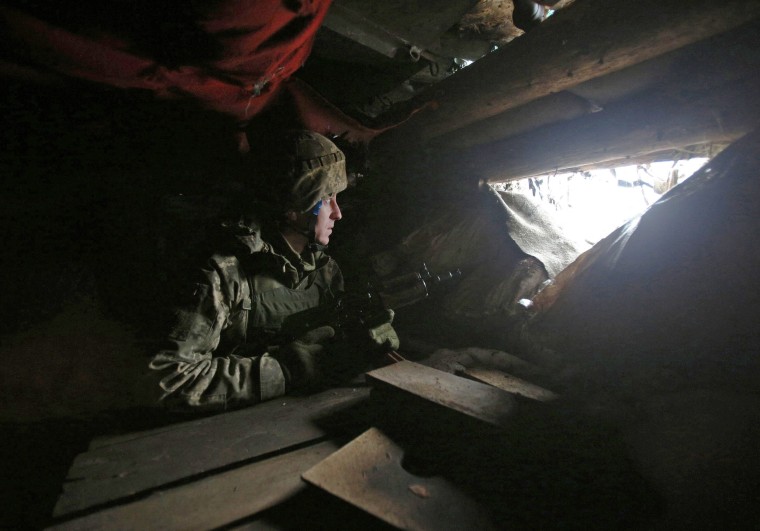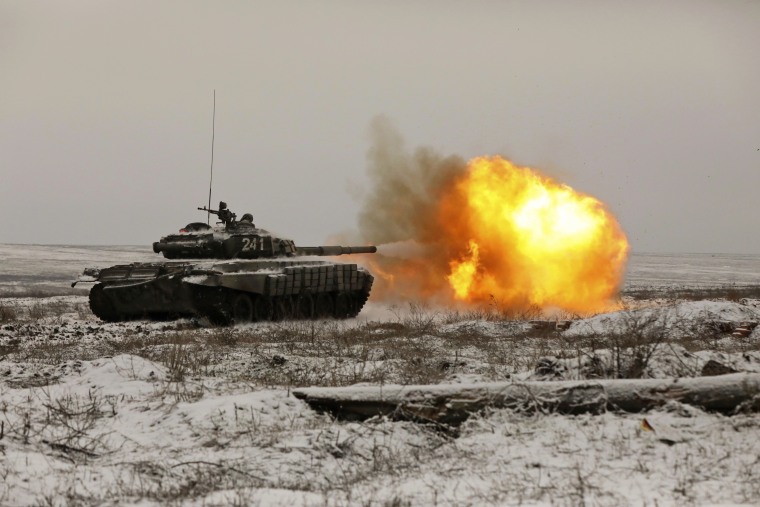With more than 100,000 Russian troops deployed on Ukraine's border, President Vladimir Putin is keeping the West guessing: Will he opt for a full-scale invasion or a more limited operation or simply keep Russian forces in place to maintain pressure on Kyiv and the West?
Enjoying an overwhelming military advantage over Ukraine's smaller, less advanced forces, Russia has a variety of options if Putin decides to launch an attack, depending on what Moscow wants to achieve, the price it is willing to pay and how the West responds, experts say.
With Russia's formidable air and naval power, any offensive would most likely feature bombing raids, missile strikes and cyberattacks that could devastate Ukraine's military infrastructure, disrupt communications and pin down ground troops.
"There's an incredibly large force that's on the border," much larger than the one that invaded and annexed Ukraine's Crimean peninsula in 2014, said Philip Breedlove, a retired four-star U.S. Air Force general who was NATO's supreme commander from 2013 to 2016.
"You have a Ukrainian land army that has gotten much better, much more capable," since 2014, said Breedlove, who is now at the Middle East Institute, a Washington-based think tank. "But the Russians would own the air and the sea."
It's still possible Russia could pull back its troops, although Moscow's tough language suggests otherwise. After talks with U.S. diplomats Monday and with NATO members Wednesday, Deputy Foreign Minister Sergei Ryabkov told Russia's RTVI that there was no reason to schedule more talks with the Americans and NATO because of what he said was their refusal to meet Moscow's demands to return to a 1997 status quo in European security.
Short of a full-blown invasion and occupation of all of eastern Ukraine, Russia could choose to take more limited actions that could increase its leverage over Kyiv and test Western resolve and trans-Atlantic unity, Breedlove and other experts say.
Before Russia launches an offensive, it would most likely accuse Ukraine of a provocation, giving Putin an alleged rationale for action, experts say. Former U.S. diplomats, retired military officers and Russia experts disagree about what Putin might be willing to do, but they point to several potential scenarios:
Cut off Ukraine's army
Most of Ukraine's combat forces are deployed along a "contact line" in the eastern Donbass region, where they are facing off against separatists backed by Moscow. If the Kremlin rapidly moved armored units to the west of the front line, it could cut off and trap much of Ukraine's ground troops without having to occupy major cities, experts said.
If Russian troops moved fast enough to outflank Ukraine's ground forces, they could capture prisoners and seize weapons and equipment, said Scott Boston, a defense analyst with the Rand Corp. think tank.
"It would be a potentially enormous blow to Ukrainian military capability," Boston said. The conflict in eastern Ukraine began after pro-Russian separatists declared independence in the Donetsk and Luhansk regions in the country's east two months after Russia seized and annexed the Crimean peninsula in March 2014. NATO and Ukraine say Russia has launched cross-border artillery attacks, armed the separatists and moved weapons and personnel into the area. Moscow denies any involvement.
Blockade Ukraine's ports
While the world's attention has focused on Russia's troop buildup on its land border with Ukraine, Moscow also has expanded its naval power near Ukraine's coast, including amphibious forces and naval infantry, experts said.
"The sea is Ukraine's weakest spot," said Taras Chmut, a Ukrainian military expert in Kyiv. The Russians "can do whatever they want in the Black Sea."
Russian naval ships now dominate the Sea of Azov, a small body of water between Ukraine and Russia, where Ukraine's modest navy is badly outgunned.
Moscow increasingly restricts the movement of Ukrainian-bound vessels in the area, and experts say Russia could blockade the southeastern port cities of Berdyansk and Mariupol, choking off an important shipping channel.
In the Black Sea, west of occupied Crimea, Russian warships could cut off the Ukrainian port cities of Odessa, Mykolaiv and Kherso, which are crucial lifelines to global markets. Such a move is well within Russia's naval capabilities, and it could bring Ukraine's economy to its knees, the country's former defense minister Andriy Zagorodnyuk warned in June.
A Russian naval operation would be likely to include the seizure of a tiny island in the Black Sea known as Snake Island, or Zmiyiniy Ostriv. Ukraine controls Snake Island, enabling Kyiv to claim territorial waters that extend 12 nautical miles from the island and helping to safeguard shipping lanes to the country's Black Sea ports.
Seize southern canal, land bridge
In addition to strangling Ukraine's commercial ports, Russia could launch other operations in the south to consolidate its occupation of Crimea, experts say. Russian forces could move to secure a canal that Kyiv shut down in 2014. The closing of the canal has created a chronic water supply problem on the Russian-held peninsula. Moscow could also try to forge a land bridge between Crimea and the rest of Ukraine, possibly linking up with territory held by pro-Russian separatists.
"The idea of building that land bridge and seizing that water supply area, I think that's very much on the table," Breedlove said.
Secure or expand separatist-held area
Putin could order Russian troops to enter separatist-held areas in the east in a mostly symbolic show of force. Western governments and Ukrainian officials say Russian forces and Russian-armed proxies are already on the ground. By rolling into separatist-controlled areas in an explicit way, Russia could keep tensions with Kyiv high without having to fire a shot, Breedlove and some experts said.
In addition, Russia could seek to extend the separatist-controlled area, possibly by seizing communication points or power plants that would make the region more viable as a separate quasi-state.

"The most likely military scenario in my view is going to be a series of rolling operations that they can stop at any point along the way based on how the West reacts," said Ben Hodges, a retired lieutenant general who was commander of U.S. Army Europe from 2014 to 2017.
Seizing a smaller area or strategic location, such as Snake Island in the Black Sea, the water canal to Crimea or areas near separatist-held territory, and then pausing would lower the risk of casualties and make it "more difficult for the West to respond," said Hodges, who is now at the Center for European Policy Analysis.
Moscow could try to gamble that limited action would fracture NATO's unity, as some European governments might be reluctant to impose severe penalties in that case, Hodges said. Without a sharp response, Russia might then press ahead with more operations.
Seize eastern half of Ukraine
In the worst-case scenario, Russia would launch an air and ground campaign across Ukraine to seize the entire Donbass region east of the Dnieper River.
A massive invasion and occupation — what Hodges, the retired Army general, calls "the big red arrow" across Ukraine — is less likely, and it's not clear that Russia has sufficient forces to hold that much territory, several experts said.
But under Putin's rule, Russia has invaded Ukraine before, and it invaded Georgia in 2008. It also intervened in Syria to support the regime of Bashar al-Assad. In each case, Western governments were taken by surprise. And in each case, the threat of sanctions failed to dissuade Putin.
"Sanctions are an incredibly weak deterrent and have consistently failed to deter Russia from the use of force in Ukraine and elsewhere," said Michael Kofman, the research program director in the Russia Studies Program at CNA, a Washington-area think tank.
Given Putin's track record, there is no reason to rule out another invasion of Ukraine, Kofman said. Russia's invasion in Georgia 14 years ago offers a rough analogy for a similar operation in Ukraine, he said. In 2008, Russia launched a major military offensive to prevent the Georgian government from re-establishing control over the regions of South Ossetia and Abkhazia, and the operation succeeded in imposing a political outcome in line with Moscow's interests.
If Russia were to opt for a larger operation, it could decide to avoid a long-term occupation of cities and simply pull back after having inflicted a devastating strike to Ukraine's army, some experts said.
Previous smaller-scale operations failed to resolve Russia's dispute with Ukraine or to meet Moscow's political objectives, Kofman said. "If they weren't able to compel Ukraine towards a desirable outcome by taking half of the Donbass, what would another limited incursion achieve exactly?" he said.
Russia could seize much of the east and demand a new political arrangement from Kyiv or simply annex the area, as it did with Crimea, experts said.
In the meantime, Russia's buildup continues. Military analysts say Russia is sending units from the country's far east on trains bound for the western region near Ukraine.
"They're still gathering forces," Kofman said.
